Terril reviews the Cimarron 1849 Colt Revolver.
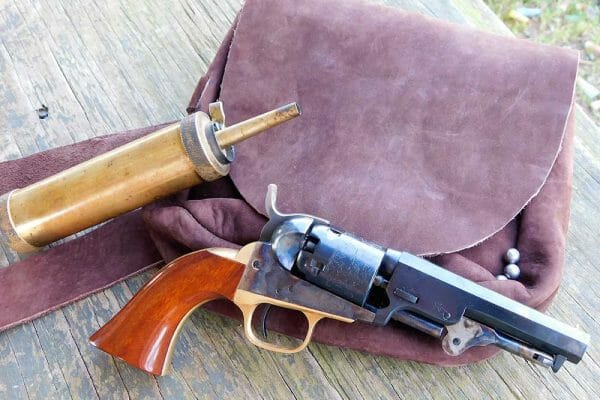
Cap and ball revolvers are inexpensive and yet still practical firearms for many applications.
Hunting and target shooting are natural applications for those willing to undertake the challenge. Still, in my opinion, percussion revolvers stay popular today because of the link they provide us with our past, not only as part of firearms evolution but also to the characters, both legendary, villainous, and ordinary, who carried them.
After touching off a Colt Navy and hitting a target at seventy-five yards, who wouldn’t feel like Wild Bill Hickok?
Large frame 36 and 44-caliber revolvers are probably the most popular today for that added boom and power that every handgun enthusiast craves, regardless of the era. The most popular revolvers of this time, the pocket 31 caliber pistols, were not famous or colorful but a weapon of the ordinary man and woman; it is a class of pistol I have a particular affection for.
To call me a “Pocket 31” aficionado would be an understatement. Out of what new product is on the market today, I have owned the curiously tiny Remington Pocket, the abbreviated Colt Baby Dragoon, and of course, the Colt 1849, a gun that I have been around not just once but now twice as I also put rounds through a Cimarron-produced Uberti Colt 1849.
Colt’s 1849 Pocket Revolver
The Mexican War brought Samuel Colt back into the gun business, but it was realized that his reformed company couldn’t live only by military contracts. He needed a peacetime staple, and the late 1840s seemed like the perfect time. The US had wrested vast swaths of land from Mexico, and the Oregon issue had settled down. More settlers from the East drifted to the West. Then, like now, there was more to fear from two-legged predators than the four-legged kind, especially when one’s definition of property was quite liberal in the absence of law enforcement. Work was physical, and distances traveled could be lengthy. The gun had to be light and out of the way. Sam Colt developed a pint-sized version of his big Dragoon revolver and gave it a 31 caliber bore, putting it on the market as the Baby Dragoon. It wasn’t perfect, and after some refinements, it was marketed as the Colt Pocket.
This five-shot single-action revolver was small enough to fit into a coat pocket or tuck into a waistband without losing your trousers. It also gave more firepower compared to the single-shot and double-barreled alternatives. The 1849 would be produced both at Colt’s Hartford plant and in his London subsidiary. When production finally stopped in 1873, over 300,000 units had been built, making it Colt’s most popular handgun until the twentieth century. You might call the 1849 a little legend, but today, these guns are far less prevalent on the reproduction market.
Cimarron 1849 Colt Revolver
Cimarron Firearms out of Fredricksburg, Texas, imports today’s Colt 1849 revolvers from the manufacturer, Uberti of Italy. Cimarron’s version differs somewhat from the base model offered for import.
At first glance, it was easy to get distracted by the contrasting colors and shapes when I first opened the box and retrieved the pistol. It is entirely faithful to the original lines and features of what was produced generations earlier.
The pistol’s open top mechanism gives it a specific Victorian look, with the engraved five-shot cylinder sitting proudly with no top strap between a four-inch octagonal barrel and the casehardened hammer. The barrel even has a Cimarron address stamp on the top flat, much like Colt’s address stamp on the original gun. A casehardened loading lever sits below the barrel and snakes through the frame, which is also casehardened in the same manner. The steel frame gives way to the brass grip frame and a one-piece walnut grip.
Live Inventory Price Checker
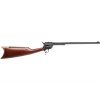
|
CIMARRON Revolving Carbine 357 Mag / 38 Special 18" 6rd Revolver - Blued | Black Walnut | KYGUNCO | $ 808.29 |
|
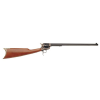
|
Cimarron Revolving Carbine .45 Colt Semi-Auto, Wood - MP419 | Palmetto State Armory | $ 873.99 |
|
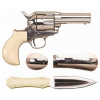
|
CIMARRON Doc Holliday Combo 45LC 3.5" 6rd Revolver w/ Dagger - Ivory / Nickel | KYGUNCO | $ 1460.27 |
|
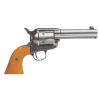
|
Cimarron Firearms Rooster Shooter Hollywood Series .45 LC Revolver, Original - RS410 | Palmetto State Armory | $ 935.99 |
|
Operationally, the 1849 is single action—requiring that the hammer is cocked for every shot and the only function of the trigger is to drop the hammer. You will also need to cock the hammer to aim, as the 1849 uses a notched rear sight ground into the hammer that is exposed when the hammer is back. The front sight is a small brass bead. The package weighs in at just over one pound and will nominally need a .321-.330-inch conical bullet or lead ball for ammunition.
Cimarron 1849 Colt Revolver Trigger Time
Percussion revolvers tend to be their own animal when it comes to performance and handling. Some have run flawlessly out of the box, while some others required five minutes of stoning on the hammer face to fix cap jamming issues. This solution, first pitched by my friend Matt Murphey of Murpheysmuskets, eliminates cap jamming issues. It was interesting that this was one of those pistols that ran flawlessly out of the box.
I came equipped with a pouch full of .323-inch lead round balls, Remington No. 10 caps, and a flask of Graf & Son’s FFFg black powder, along with plenty of targets.
Like with any percussion firearm, to ready for loading, place percussion caps on each nipple and fire them. This burns off the oil left over from storage.
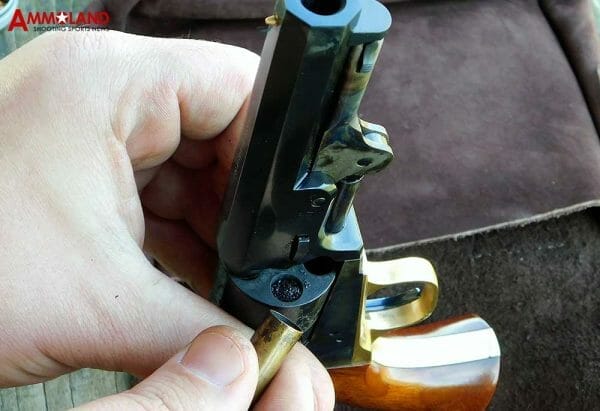
Though the 1849 Colt was traditionally loaded with paper cartridges, I loaded each chamber with loose powder and ball. First, draw the hammer to half-cock to free the cylinder. Drop a charge of black powder in each chamber and follow putting a round ball on each chamber before pushing them into the cylinder with the loading lever.
At this time, you can elect to put grease over the balls. This helps keep the black powder fouling soft. My one-hundred-round battery of test was done without such lubrication.
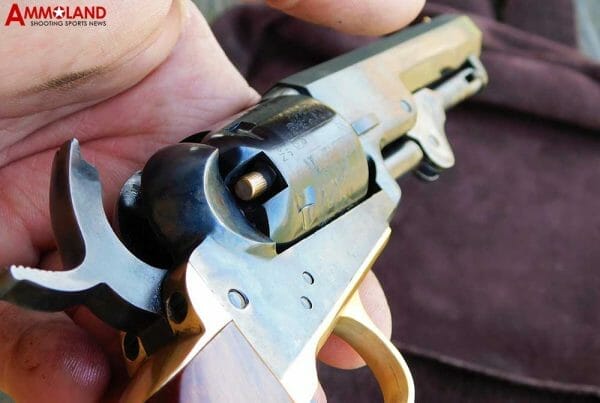
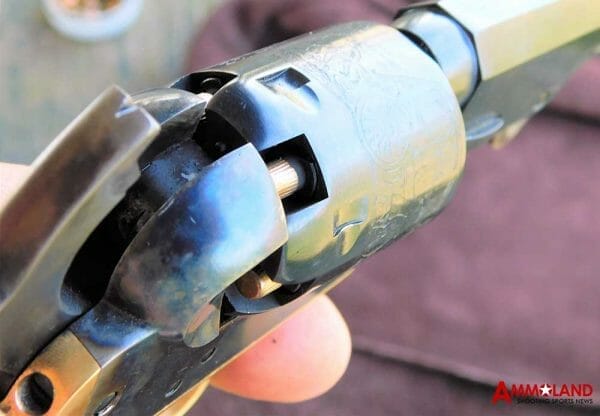
Next, push new percussion caps onto each nipple and lower the hammer onto the safety notch to rest the hammer between two loaded chambers to prevent accidental discharge should the gun be dropped. Put in a holster or a pocket, and you are ready to take on any 19th-century miscreant.
One aspect I like about the 1849 is the fact that it will hold more powder than the Remington Pocket models. I was able to load twenty grains of powder and still had enough room to squeeze a ball on top. This is certainly a maximum load, but even so, recoil was very light—much like a modern 22 rimfire pistol but with the added authority of smoke and flame.
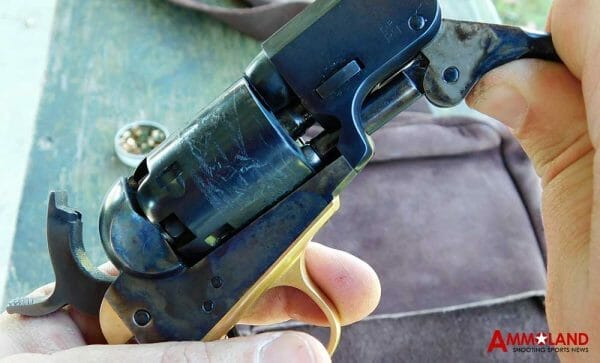
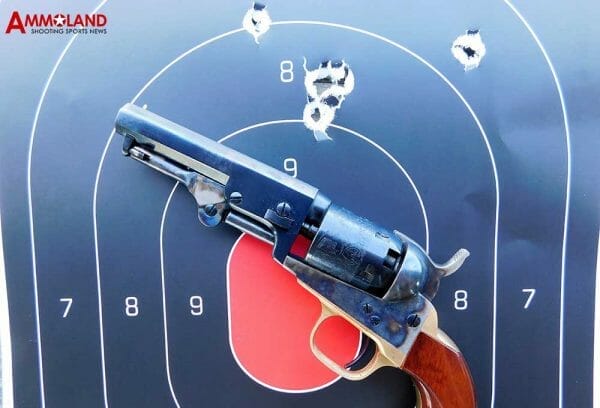
The 1849’s grip frame allows for all fingers to be on the gun while firing, and the hammer has just enough reach to thumb-cock with one hand easily without breaking your grip. The sights are something of a bother, given how small they are, but they do allow you to draw a fine bead on your target. That should lead to good accuracy, right?
Despite being a hand-filler and a natural pointer, the Pocket is light, and it lacks the long barrel used on other guns to balance the piece for accurate shooting. Throw in the fact that even the Pocket handguns were historically sighted to shoot to the point of aim at seventy-five yards, and we are up to a challenge. Once I held steady and broke the crisp trigger consistently, everything improved. Two-inch groups at seven yards became the norm, though all groups printed eight inches high due to that seventy-five-yard zero. I ended up firing a total of one hundred rounds for the day without any cap jams and without any black powder fouling gumming up the action—a distinct advantage to the open-top Colt design.
Cimarron Uberti 1849 Colt Revolver Disassembly
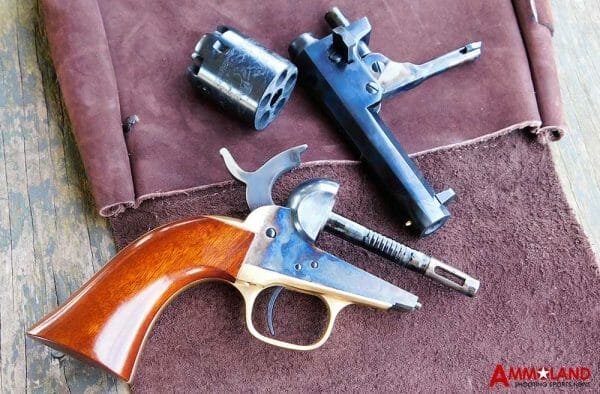
Another advantage of the Colt design is the ease of disassembly. Use a small tool like a clothespin—or in my case, the back of my powder flask—to drive out the cylinder wedge. Dismount the barrel and cylinder, and you are ready to clean.
Cimarron 1849 Colt Revolver in Summary
While not as diminutive as today’s pocket pistols, small-handed and large-handed shooters alike will enjoy that Peacemaker-style of grip pioneered by the 1849. Aesthetically, the Pocket loses nothing over the more well-known Navy and Army models. Loading is a little more challenging, having to hit smaller chambers with powder and working around a short loading lever and a small exposed area to cap the gun. Regarding function, Cimarron did an excellent job by putting out a pistol that not only looks good but functions very well.
The Cimarron 1849 Colt Revolver’s 31-caliber bore won’t satisfy a power junkie, but it will do just about anything a 22 LR can with the added smoke and flame heightening respect with every shot. The pistol’s small caliber made it portable in its day, but now the benefits are low recoil and a low cost of shooting. Powder consumption is very low as is lead, ideal for a plinker or woods gun. A special supply of ammunition is not needed with standard black powder or a reasonable substitute, and a supply of 00 buckshot pellets can keep you firing for a long while.
About Terril Hebert:
Terril Hebert is a firearm writer native to south Louisiana. Under his motto-Guns, Never Politics-he tackles firearm and reloading topics both in print and on his Mark3smle YouTube channel, where he got his start. Terril has a soft spot for ballistics testing, pocket pistols, and French rifles. When he is not burning ammo, he is indulging his unhealthy wildlife photography obsession or working on his latest novel. Scourge of God, published in 2017. See more from Terril on youtube under Mark3smle.

Given the Kirst and the BP cylinders are interchangeable, in about 30 seconds, this gives you many more choices.Ejector spring set optional…
Another option with the Pocket navy is to obtain a Kirst converter and a box of .32 cartridges. fairly easy and relatively cheap in the long run, re-creates a mason conversion cira 1871..
This was the revolver used by Orrin Porter Rockwell one of the west great gunfighters and Marshall!
Try it with the Howell cartridge conversion and it is loads of fun to shoot with factory fixed ammo.